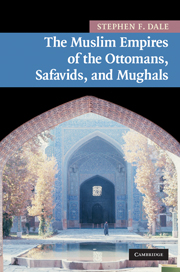Book contents
- Frontmatter
- Contents
- List of illustrations
- List of maps
- Preface
- Languages and transliteration
- Introduction
- 1 India, Iran, and Anatolia from the tenth to the sixteenth century
- 2 The rise of Muslim empires
- 3 The legitimacy of monarchs and the institutions of empires
- 4 The economies around 1600
- 5 Imperial cultures
- 6 Golden ages: profane and sacred empires
- 7 Imperial culture in the golden age
- 8 Quests for a phoenix
- Conclusion
- Glossary
- Dynastic lists
- Bibliography
- Index
7 - Imperial culture in the golden age
Published online by Cambridge University Press: 05 October 2014
- Frontmatter
- Contents
- List of illustrations
- List of maps
- Preface
- Languages and transliteration
- Introduction
- 1 India, Iran, and Anatolia from the tenth to the sixteenth century
- 2 The rise of Muslim empires
- 3 The legitimacy of monarchs and the institutions of empires
- 4 The economies around 1600
- 5 Imperial cultures
- 6 Golden ages: profane and sacred empires
- 7 Imperial culture in the golden age
- 8 Quests for a phoenix
- Conclusion
- Glossary
- Dynastic lists
- Bibliography
- Index
Summary
Introduction
Süleyman the Magnificent and Shah Jahan both thought of themselves as epochal figures, each in his own mind a Solomon, each in his own mind a unique dynastic individual: Süleyman the Padishah-i Islam, the “Monarch of Islam”; Shah Jahan, the Sahib-i Qiran-i Sani, the “Second Lord of the Auspicious Conjunction,” the Second Temür. Each man constructed monumental buildings to glorify and legitimize his reign. In the Ottoman Empire Süleyman employed the architect Sinan to erect magnificent imperial masjids in Istanbul and Edirne, proclaiming both Süleyman's majesty and his Sunni orthodoxy, while in India Shah Jahan closely supervised costly building projects ranging from the marble enclosure for Babur's Kabul tomb to the construction of a new royal city in Delhi, all of these overshadowed by the Taj Mahal. In Iran after Shah ‘Abbas I no Persian Solomon emulated Süleyman or Shah Jahan – or even claimed to be the agent or precursor of the Twelfth Imam. The most important building of the impoverished, politically quiescent late Safavid era was, appropriately enough, Shah Sultan Husain's new masjid and madrasa complex in Isfahan, a modest place of quiet beauty built near Shah ‘Abbas's great Maidan. Poetry and painting continued to evolve in Süleyman's and Shah Jahan's empires, as they did in Iran, but it is the seventeenth-century Iranian poet Sa'ib whose work constitutes what is probably the most important literary achievement of this era.
- Type
- Chapter
- Information
- The Muslim Empires of the Ottomans, Safavids, and Mughals , pp. 208 - 246Publisher: Cambridge University PressPrint publication year: 2009



